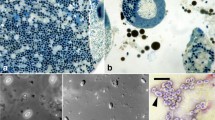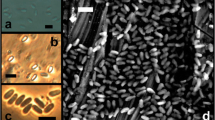Abstract
A microsporidium was found in a Mediterranean cricket Gryllus bimaculatus from a pet market in the UK and a lab stock at the Moscow Zoo (originating from London Zoo). The spores were ovoid, uninucleate, 6.3 × 3.7 μm in size (unfixed), in packets by of 8, 16, or 32. The spores were easily discharged upon dessication or slight mechanical pressure. The polar tube was isofilar, with 15–16 coils arranged in 1–2 rows. The polaroplast was composed of thin lamellae and occupied about one third of the spore volume. The endospore was 200 nm thick, thinning over the anchoring disc. The exospore was thin, uniform, and with no ornamentation. Phylogenetics based upon small subunit ribosomal RNA (Genbank accession # MG663123) and RNA polymerase II largest subunit (# MG664544) genes placed the parasite at the base of the Trachipleistophora/Vavraia lineage. The RPB1 locus was polymorphic but similar genetic structure and identical clones were found in both isolates, confirming their common geographic origin. Due to in insufficient ultrastructural data and prominent divergence from described species, the parasite is provisionally placed to the collective taxon Microsporidium.




Similar content being viewed by others
References
Ayieko MA, Ogola HG, Ayieko IA (2016) Introducing rearing crickets (gryllids) at household levels: adoption, processing and nutritional values. J Insects Food Feed 2:203–211. https://doi.org/10.3920/JIFF2015.0080
Cheney SA, Lafranchi-Tristem NJ, Canning EU (2000) Phylogenetic relationships of Pleistophora-like microsporidia based on small subunit ribosomal DNA sequences and implications for the source of Trachipleistophora hominis infections. J Eukaryot Microbiol 47:280–287. https://doi.org/10.1111/j.1550-7408.2000.tb00048.x
Cheney SA, Lafranchi-Tristem NJ, Bourges D, Canning EU (2001) Relationships of microsporidian genera, with emphasis on the polysporous genera, revealed by sequences of the largest subunit of RNA polymerase II (RPB1). J Eukaryot Microbiol 48:111–117
Choudhary MM, Metcalfe MG, Arrambide K, Bern C, Visvesvara GS, Pieniazek NJ, Bandea RD, DeLeon-Carnes M, Adem P, Choudhary MM, Zaki SR, Saeed MU (2011) Tubulinosema sp. microsporidian myositis in immunosuppressed patient. Emerg Infect Dis 17:1727–1730. https://doi.org/10.3201/eid1709.101926
Hall TA (1999) BioEdit: a user-friendly biological sequence alignment editor and analysis program for Windows 95/98/NT. Nucleic Acids Symp Ser 41:95–98
Hollister WS, Canning EU, Weidner E, Field AS, Kench J, Marriott DJ (1996) Development and ultrastructure of Trachipleistophora hominis n.g., n.sp. after in vitro isolation from an AIDS patient and inoculation into athymic mice. Parasitology 112:143–154
Jones DT, Taylor WR, Thornton JM (1992) The rapid generation of mutation data matrices from protein sequences. Comput Appl Biosci 8:275–282
Just F, Essbauer S, Ahne W, Blahak S (2001) Occurrence of an invertebrate iridescent-like virus (Iridoviridae) in reptiles. J Veterinary Med Ser B 48:685–694
Kimura M (1980) A simple method for estimating evolutionary rate of base substitutions through comparative studies of nucleotide sequences. J Mol Evol 16:111–120
Kumar S, Stecher G, Tamura K (2015) MEGA7: Molecular Evolutionary Genetics Analysis version 7.0. Mol Biol Evol 33:1870–1874. https://doi.org/10.1093/molbev/msw054
Lorbacher de Ruiz H, Gelderblom H, Hofmann W, Darai G (1986) Insect iridescent virus type 6 induced toxic degenerative hepatitis in mice. Med Microbiol Immunol 175:43–53
Meissner EG, Bennett JE, Qvarnstrom Y, da Silva A, Chu EY, Tsokos M, Gea-Banacloche J (2012) Disseminated microsporidiosis in an immunosuppressed patient. Emerg Infect Dis 18:1155–1158. https://doi.org/10.3201/eid1807.120047
Sambrook J, Fritsch E, Maniatis T (1989) Molecular cloning: a laboratory manual. Cold Spring Harbor Laboratory, Cold Spring Harbor
Schneider CA, Rasband WS, Eliceiri KW (2012) NIH Image to ImageJ: 25 years of image analysis. Nat Methods 9:671–675. https://doi.org/10.1038/nmeth.2089
Silvestro D, Michalak I (2012) RaxmlGUI: a graphical front-end for RAxML. Org Divers Evol 12:335–337. https://doi.org/10.1007/s13127-011-0056-0
Sokolova YY, Dolgikh VV, Morzhina EV, Nassonova ES, Issi IV, Terry RS, Ironside JE, Smith JE, Vossbrinck CR (2003) Establishment of the new genus Paranosema based on the ultrastructure and molecular phylogeny of the type species Paranosema grylli Gen. Nov., Comb. Nov. (Sokolova, Selezniov, Dolgikh, Issi 1994), from the cricket Gryllus bimaculatus Deg. J Invertebr Pathol 84:159–172. https://doi.org/10.1016/j.jip.2003.10.004
Sprague V, Becnel JJ, Hazard EI (1992) Taxonomy of phylum Microspora. Crit Rev Microbiol 18:285–395
Vandeweyer D, Crauwels S, Lievens B, Van Campenhout L (2017) Metagenetic analysis of the bacterial communities of edible insects from diverse production cycles at industrial rearing companies. Int J Food Microbiol 261:11–18. https://doi.org/10.1016/j.ijfoodmicro.2017.08.018
Vavra J, Kamler M, Modry D, Koudela B (2011) Opportunistic nature of the mammalian microsporidia: experimental transmission of Trachipleistophora extenrec (Fungi: microsporidia) between mammalian and insect hosts. Parasitol Res 108:1565–1573. https://doi.org/10.1007/s00436-010-2213-3
Vogelstein B, Gillespie D (1979) Preparative and analytical purification of DNA from agarose. Proc Natl Acad Sci U S A 76:615–619
Vossbrinck CR, Debrunner-Vossbrinck BA (2005) Molecular phylogeny of the Microsporidia: ecological, ultrastructural and taxonomic considerations. Folia Parasitol 52:131–142. https://doi.org/10.14411/fp.2005.017
Vossbrinck CR, Debrunner-Vossbrinck BA, Weiss LM (2014) Molecular phylogeny of the Microsporidia. In: Weiss LM, Becnel JJ (eds) Microsporidia: pathogens of opportunity. Wiley-Blackwell, pp 203–220
Weidner E, Canning EU, Rutledge CR, Meek CL (1999) Mosquito (Diptera: Culicidae) host compatibility and vector competency for the human myositic parasite Trachipleistophora hominis (Phylum Microspora). J Med Entomol 36:522–525
Weiser J, Wegensteiner R, Zizka Z (1997) Ultrastructures of Nosema typographi Weiser 1955 (Microspora: Nosematidae) of the Bark Beetle Ips typographus L. (Coleoptera; Scolytidae). J Invertebr Pathol 70:156–160
Weiss LH, Vossbrinck CR (1999) Molecular biology, molecular phylogeny, and molecular diagnostic approaches to the microsporidia. In: Wittner M, Weiss LM (eds) The microsporidia and microsporidiosis. ASM Press, Washington, pp 129–171
Funding
This study was funded by the Russian Science Foundation (grant # 16-14-00005).
Author information
Authors and Affiliations
Corresponding author
Ethics declarations
Conflict of interest
The authors declare that they have no conflict of interest.
Rights and permissions
About this article
Cite this article
Tokarev, Y.S., Peat, K.M., Malysh, J.M. et al. Discovery of a novel microsporidium in laboratory colonies of Mediterranean cricket Gryllus bimaculatus (Orthoptera: Gryllidae): Microsporidium grylli sp. nov.. Parasitol Res 117, 2823–2829 (2018). https://doi.org/10.1007/s00436-018-5970-z
Received:
Accepted:
Published:
Issue Date:
DOI: https://doi.org/10.1007/s00436-018-5970-z




